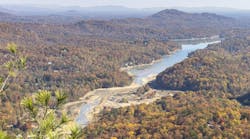About the author: Chuck Brown is director of operations for the Upper Colorado River Authority. Brown can be reached at [email protected] or 325.655.0565.
San Angelo, located in west central Texas, lies on the southwestern edge of the Edwards Plateau and the northeastern edge of the Chihuahuan Desert at the confluence of the North and South Concho rivers. It has a semi-arid climate, receiving 20 in. of rain annually.
San Angelo was established in 1867 around Ft. Concho, a series of new forts designed to protect the frontier from hostile threats. As San Angelo grew, dams were constructed upstream of the city to provide flood control as well as a municipal and irrigation water supply.
Fighting Harmful Flood Flows
Since the construction of the dams, the North and South Concho rivers through urbanized San Angelo have become a series of storm water ponds with little or no base flows. Typical flood flows derive strictly from impervious runoff within the urbanized area, and as a result, water quality degradation has occurred. The North Concho River, which runs through the heart of the city, became severely impacted by nonpoint source pollution, leading to low dissolved oxygen values, numerous fish kills and unsightly conditions.
To mitigate this problem, the Upper Colorado River Authority (UCRA) began applying for grants from the U.S. Environmental Protection Agency’s (EPA) 319(h) nonpoint source pollution program, administered through the Texas Commission on Environmental Quality (TCEQ). With these funds, several retention and filter structures were constructed from 1994 to 2004 on targeted watersheds with high suspended solids and nutrient loadings.
Culmination of Construction
The final project, the Downtown San Angelo Project, was completed in 2007 and showcases not only storm water treatment, but also serves as an aesthetically pleasing water feature and an educational tool for the recently constructed Concho Basin Aquatic Education and Research Center. This treatment system intercepts storm water from a 6-acre subbasin within the heart of the city before it reaches the river.
The water is piped into a vortex separator; the heavier solids settle to the bottom of the separator, while the floatables are trapped at the top. The cleanest mid-column of water is piped into a sand filtration system and then to a pump vault. The pumps force the water uphill to a series of ponds, and the water gravity flows through the ponds and back into the filtration system.
Each pond holds about 15,000 gal of water and provides additional treatment to the storm water. As water cascades from pond to pond, oxygen is introduced by the waterfalls between each pond and native aquatic plants remove nutrients from the water. During a storm event, water within the treatment system is displaced by incoming storm water, and the cycle repeats as treated water is discharged to the river. Samples of inflows versus discharges show the reduction of nutrients to be as much as 70%, and suspended solids loadings have been reduced by as much as 95%.
Another equally important facet of the ponds and treatment system is commonly referred to as the “Living Laboratory,” a thriving ecosystem. Native predator fish such as catfish, bass and sunfish have been stocked and reside in the ponds, as do prey species like mosquito fish and shiners. Native aquatic plants such as bulrush, lilies and pondweed provide cover for the fish and remove nutrients. There is also an established benthic macroinvertebrate community thriving in the complex. This ecosystem provides an outstanding opportunity as a public educational tool for aquatic biology as well as an efficient treatment system.
Demonstration of Innovation
The Downtown San Angelo Project was a cooperative effort between the EPA, TCEQ, city of San Angelo, San Angelo Health Foundation and UCRA. The total cost came to $1.34 million, of which 40% went toward treatment. This demonstration project exhibits an innovative way in which storm water treatment systems can benefit a community in ways beyond water quality.
Download: Here

